Cajun and Zydeco Music: Flavors of Southwest Louisiana
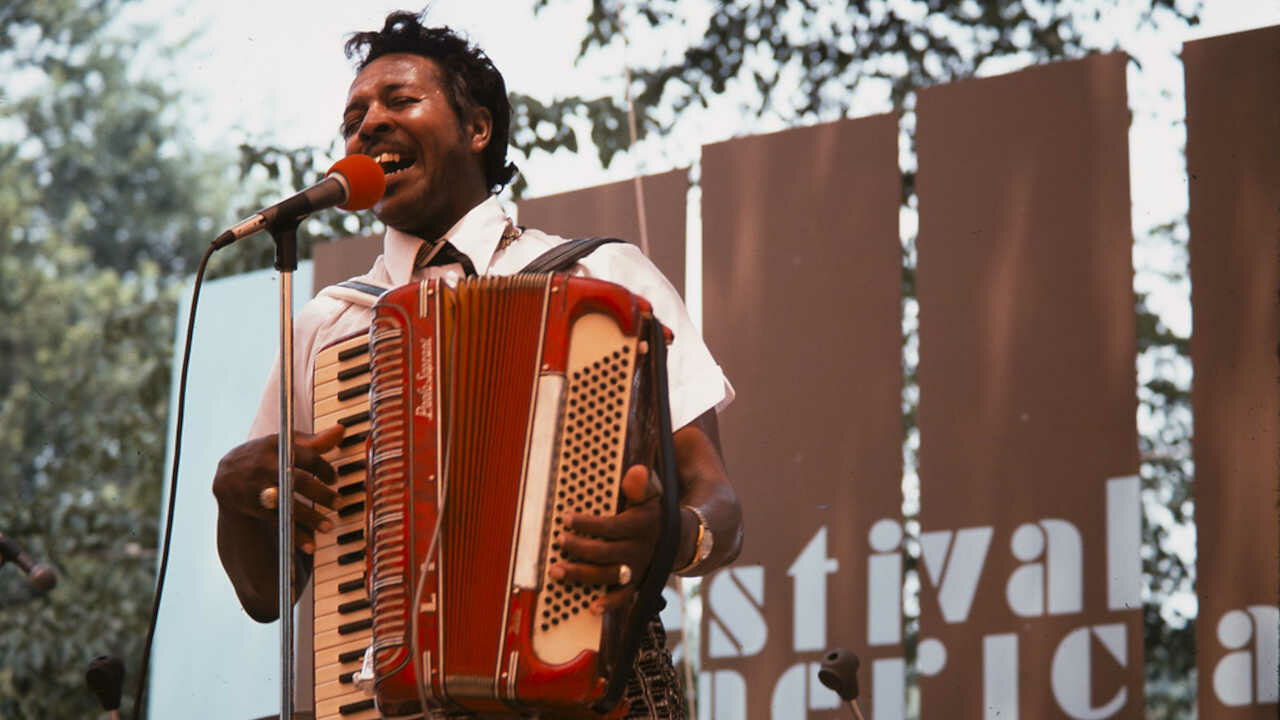
Lesson Hub 7
Stylistic Developments in Cajun Music

How has Cajun music changed over the past 100 years? How has it stayed the same?
Rodney Balfa, Dewey Balfa, Nathan Abshire, and Basile Marcentel, Basile, Louisiana, photo by Chris Strachwitz. Arhoolie Records.
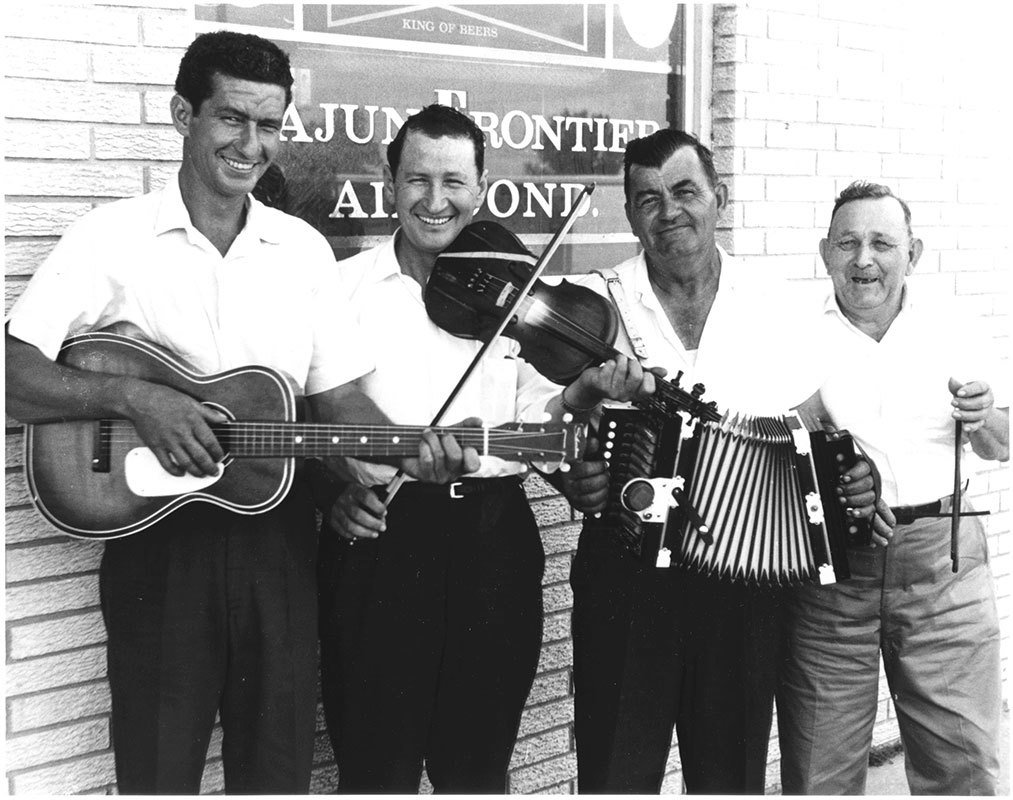

Stylistic Developments in Cajun Music
MUSIC MAKING
HISTORY & CULTURE
MUSIC LISTENING
20+ MIN
20+ MIN
30+ MIN

Cajun Music: The First Accordion Era
Path 1

20+ minutes

Accordion on Chair, unknown photographer. Folkways Records.
Early Cajun Music

When the Acadians first arrived in Louisiana in the late 1700s, they based much of their music on old narrative ballads played a cappella or on the fiddle.

Joe Falcon, photo by Chris Strachwitz. Arhoolie Records.
Cajun Fiddle Legend Dennis McGee

Throughout the 19th and 20th centuries, Cajun fiddlers were living connections to old tunes and early styles of playing.
Listen to an excerpt from this audio recording, "La Réel à Fruge," which features influential Cajun fiddler Dennis McGee.
What emotions do you hear?
Dennis McGee, photo by Chris Strachwitz. Arhoolie Records.

Loneliness in Cajun Music

The characteristic Cajun "loneliness" found in McGee’s voice and playing remained prominent throughout the 20th century; his style continues to influence modern fiddlers.

Double Fiddling

Early Cajun music was often played by two fiddles – one playing the melody, and another playing the back-up (rhythmic and harmonic accompaniment).
-
This tradition of "twin fiddles" or "double fiddle" was a predecessor of today's Cajun style and is still commonly employed in a band setting.

Cajun fiddlers Dewey Balfa and Tracy Schwarz, unknown photographer. Folkways Records.
Text
Enter the Accordion ...

Around the turn of the 20th century, the diatonic accordion also became popular among Cajun musicians, which led to a major stylistic shift in the rhythms, chords, harmony, and repertoire of the music that was played.

Traditional Cajun Accordion, cover art by Ronald Clyne. Folkways Records.
The Diatonic Accordion

The diatonic accordion was louder and sturdier, but its limited chord capacity made it harder to play the older Acadian fiddle tunes with their complex melodies, minor modes, and wide variety of keys.

As the accordion became the dominant instrument in the genre, fiddle players adapted their style in order to play along.
Generally Speaking .....
Creole Influence

The influence of Creole musicians living in the area also influenced the shift in style of Cajun music heard pre-WWII.
Creole accordion players like Amédé Ardoin (who had a strong musical partnership with Dennis McGee) laid the groundwork for much of 20th century Cajun music.

Amédé Ardoin, unknown photographer. Courtesy of Christopher King.

Creole fiddle players often incorporated syncopated rhythms and "bluesy" notes.
The Creole Influence
In the early 20th century, these elements were incorporated into the Cajun style more regularly.
Listen to an example of this style of playing
"Jolie Bassette," by Alphonse "Bois Sec" Ardoin with Canray Fontenot
Creole Fiddler Canray Fontenot, by Michael P. Smith. The Historic New Orleans Collection.
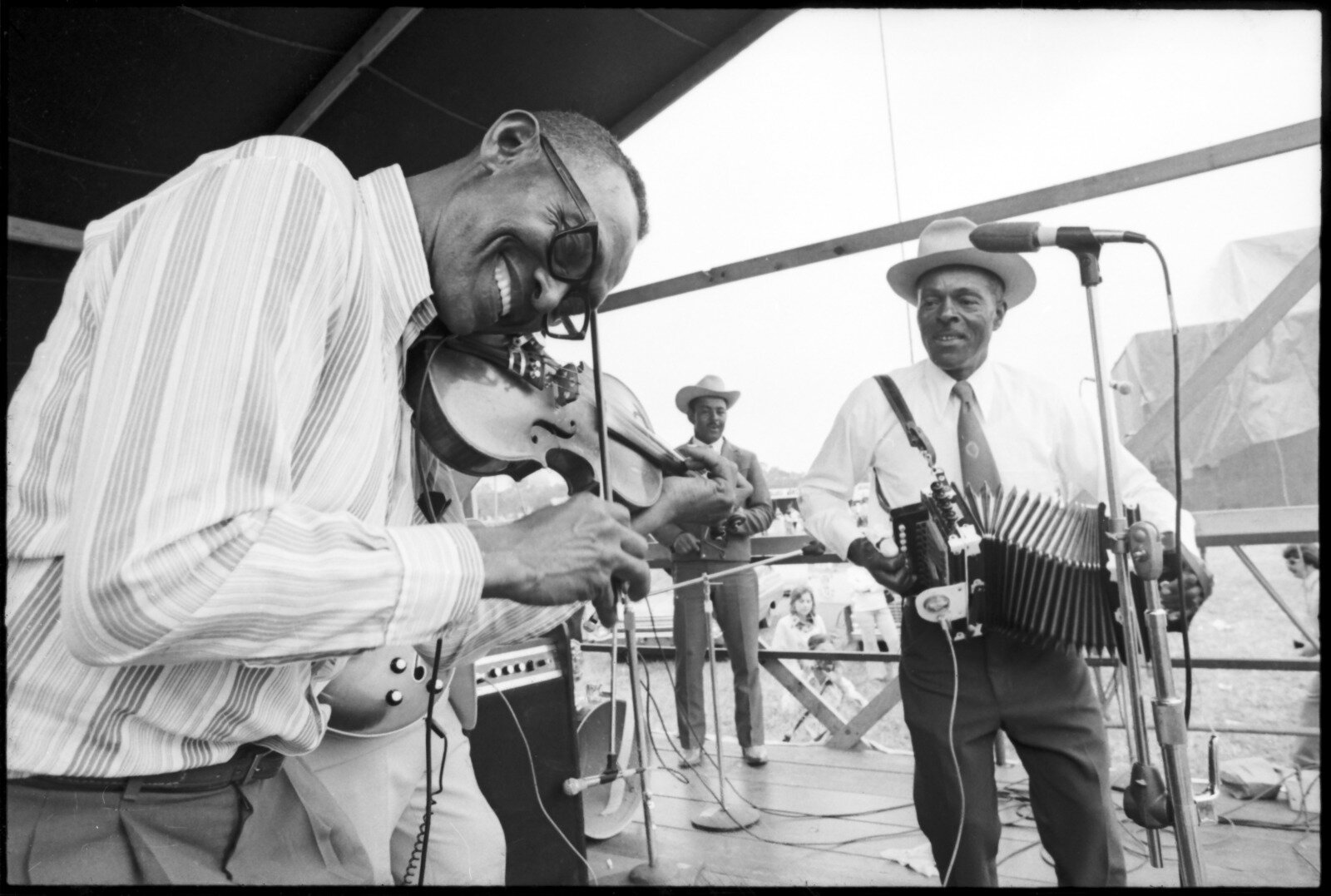
Generally Speaking .....
Music with the Family

Music is commonly a central point of social life, but for the early Cajuns, music was primarily home-made, usually at small family gatherings.
In the early 20th Century (pre-WWII), the setting for Cajun music shifted . . .

Dennis McGee, Marc [Savoy], Wilson, by Ann Savoy. Arhoolie Records.
Generally Speaking .....
Music in Dance Halls

Following the end of prohibition, dance halls popped up around the prairie. Soon the dance hall was the primary place to hear Cajun music.
This solidified the need for louder and more upbeat music.

Fais-do-do near Crowley, Louisiana, by Lee Russell. Library of Congress.
Generally Speaking .....
Music in Dance Halls

Bands in dance halls were often centered around the accordion, with a fiddle or triangle for accompaniment.
Later, the guitar was added as an important rhythmic accompaniment.

Beachball Bennys 4 May 1992, by Infrogmation of New Orleans. CC by 2.0, via Flickr.
The Rise of Radio

As radio became available on the prairies of Southwest Louisiana during the 1920s, the influence of mainstream American music was also evident in an emerging style called “Cajun country.”
The people in dance halls preferred tp hear familiar songs that they knew from listening to the radio.

1920s Radio, Emerson Radio Corporation. National Museum of American History.
Generally Speaking .....
The First Cajun Record


In 1928, Joe Falcon and his wife Cleoma Breaux recorded the very first Cajun record:
“Allons à Lafayette”
Cleoma & Joe Falcon, unknown photographer. Arhoolie Records.
Generally Speaking .....

The recordings they made for radio put Cajun music "on the map" and reflected a more modern sound for the times, which included guitar instead of fiddle.

Joe Falcon and Cléoma Falcon on their wedding day, by Johnnie Allen. PD, via Wikimedia Commons.
The First Cajun Record
Joe and Cleoma took mainstream country & western songs that were popular on the radio, translated them into French, and played them on accordion and guitar (a trend that is still common today).
Generally Speaking .....
The "Golden Accordion Era"

This time period before World War II, from roughly 1900–1934, is known as the first accordion era, but is also now sometimes referred to as the
“Golden Accordion Era”
- This was the period when "traditional Cajun music" (as it is thought of today) became truly defined.
- Many of the most popular Cajun songs of all time were written and performed during this time, and the core instrumentation of the band (accordion, fiddle, and guitar) was solidified.
Learning Checkpoint

- What are some characteristics of early Cajun music?
- Why is the time period before World War II (roughly 1900–1934) now sometimes referred to as the “golden accordion era” of Cajun music?
End of Path 1: Where will you go next?




Cajun Music: The “String Band Era” (and Beyond)
Path 2

20+ minutes


The Hackberry Ramblers. by unknown photographer. Arhoolie Records.
Changes in Cajun Music: The Influence of the Radio

By the mid-1930s, the sound of Cajun music shifted. The discovery of oil in Louisiana brought money and outside influence to the area, and the radio became more popular.
- Radio music didn't sound "Cajun."
- The popularity of the accordion declined as local musicians leaned toward more familiar sounds influenced by other genres like western swing (popular in neighboring Texas at the time), blues, and jazz.
Changes in Cajun Music: The Onset of World War II

The onset of WWII created a shortage of accordions (mostly German imports). By 1940, the accordion had been phased out almost entirely from Cajun music.
This time frame (mid-1930s to late 1940s) came to be known in Southwest Louisiana. as the string band era.

Attentive Listening: The String Band Sound

Listen to this audio track (recorded in the mid-1930s).
As you listen, write down your answers to the questions listed below:
-
What instruments do you hear?
-
Which instrument is leading the band?
-
What do you notice about the time / meter?
-
What makes this music different from Cajun music you've heard before, or from the First Accordion Era in the previous Path?
-
How is it similar?
"Gueydan Two-Step," performed by J.B. Fuselier with his Merrymakers.
Cajun String Band Instrumentation

The song you just heard, called the "Gueydan Two-Step” features the fiddle, accompanied by two acoustic guitars, a string-band style popular on the radio.
Sometimes musicians added banjos, mandolins, ukuleles, and harmonicas.
Note things that haven't changed: This song’s structure is a classic Cajun two-step, and it is sung in French.

Tenor Banjo, Bacon Banjo Co. National Museum of American History.
Resurgence of the Fiddle

During the String Band Era, the fiddle regained its place as the lead instrument in Cajun music.

American Folk Fiddle, by unknown maker. National Museum of American History.
Attentive Listening: Other Influences

Let’s listen to a different audio track recorded during this era.
As you listen, write down your answers to the questions listed below:
- What instruments do you hear?
- Which instrument is leading the band?
- What do you notice about the time / meter?
- What influences do you hear?
- Where do you think you might hear this music?
"Louisiana Boogie," performed by Harry Choates
The Influence of Country Music

Over time, the music became more polished and commercial, as selling recordings and playing them on the radio became a reliable source of income and a goal in itself.

The Fiddle King of Cajun Swing, cover design by Wayne Pope. Arhoolie Records.
This recording of "Louisiana Boogie," played by Harry Choates, references "honky-tonk" and "boogie-woogie," which are considered country music styles.
Country music had a huge influence on Cajun music during the String Band Era.
More About "Honky Tonk"

The time structure, in 4/4 instead of 2/2, is played more slowly with a "swing," or lilt to the beat.

Fender 1000 pedal steel, photo by Fender. CC-0 via Wikimedia Commons.
Honky-tonk music was characterized by the fiddle and pedal steel guitar, heard in this song with drums, another Cajun music staple.
These records were meant to emulate sounds created by popular recording artists at the time (such as Hank Williams and Bob Wills "western swing" musicians).
The Accordion Returns

After WWII, accordions again became readily available and the older, stripped-down, and traditional sound returned to the dancehalls.

Cajun musicians at the first Smithsonian Folk Life Festival in 1967, unknown photographer.
Smithsonian Institution Archives.
Generally Speaking .....
The Accordion Returns

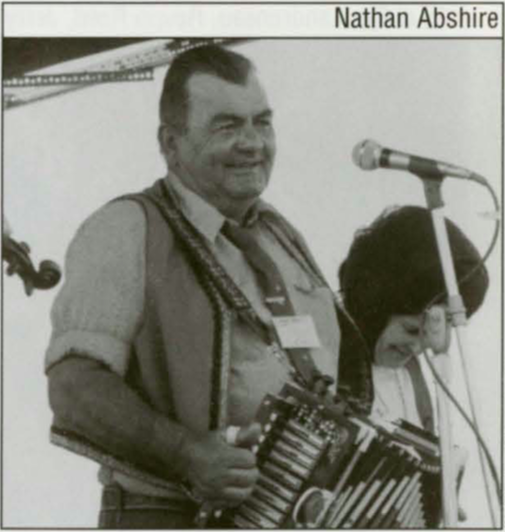
Nathan Abshire, photo by Chris Strachwitz. Arhoolie Records.
The accordion eventually found its way back into the featured spot in the Cajun band, where it remains today.
However, the steel guitar, drums, and amplification would become staples of Cajun music, and the impact of the string band era is still evident in some contemporary fiddle-playing styles.
Generally Speaking .....
Cajun Pride

Many people attribute the accordion revival to a renewed sense of Cajun pride after the war:
They longed for the unique sights, sounds, and flavors of their homeland, and this was not the commercialized sound of string bands!
Cajun soldiers returned recognizing that Cajuns were "as good as anyone else."
Generally Speaking .....

This pride and devotion to the tradition of Cajun music continued into the 1960s.

The Balfa Brothers at the 1969 Festival of American Folklife, photo by Diana Jo Davies. Smithsonian Folklife Festival.
Cajun Pride
The French language was again taught in schools, and Cajun musicians played for the first time at festivals such as the Newport Folk and the Smithsonian Folklife Festival.
Generally Speaking .....
Cajun Pride

After World War II, Cajuns had a strong sense that their culture was worth sharing.
The traditional style of Cajun music was solidified during this period, and remains evident in today's playing style.
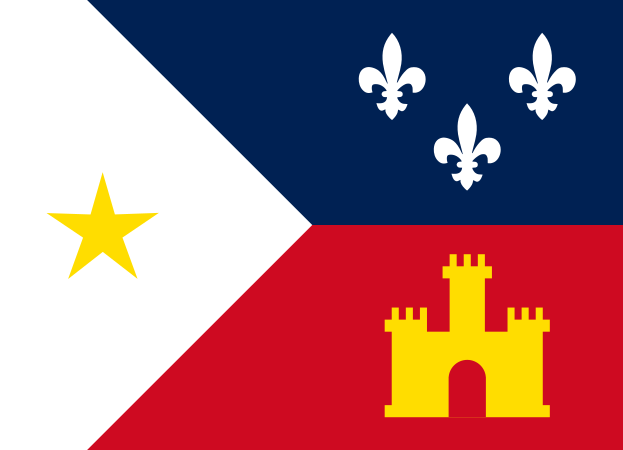
Flag of Acadiana, by Lexicon, CC0, via Wikimedia Commons.
Learning Checkpoint

- In what ways did Cajun music begin to shift during the mid-1930s?
End of Path 2: Where will you go next?



Performing "Jolie Blonde"
Path 3

30+ minutes


Jolie Blonde, cover art by Wayne Pope. Arhoolie Records.
What is a "Standard"?


They are usually the most popular, timeless, and most characteristic of the genre.
Every genre or style of music has a song or songs that stand the test of time.
These songs become "standards" that are reinterpreted by musicians again and again over the years.
"Jolie Blonde" : A Cajun Standard


Although the Cajun music repertoire is largely based on the reinterpretation of older songs, the song "Jolie Blonde" (sometimes called the "Cajun National Anthem") is undoubtedly the most widely recognized.
Can you think of examples of "standards" in other popular music genres?
"Jolie Blonde"


The song "Jolie Blonde" was originally composed and recorded during the "golden accordion era," before WWII, by accordionist Amédé Breaux.
-
The song became popular during the “string band era.”
-
A group called "The Hackberry Ramblers" was the first to make a radio “hit” with this song in 1935.

More about "Jolie Blonde"


Fiddler Harry Choates’s 1946 version of "Jolie Blonde" was a huge Cajun music radio hit.
- Since 1946, this song has been the most widely recorded (and requested) tune in Cajun music.

Arhoolie Records (acquired in 2016 by Smithsonian Folkways Recordings) released many renditions of this song . . . zydeco artists have recorded it, too!
Active Music Making: Perform "Jolie Blonde"


In the next activity, you will learn the Cajun classic "Jolie Blonde!" (in the style of The Hackberry Ramblers)

Suggestion 1: Sing Along (Learn the Melody)


-
Play the recording, while following along with the lyrics/translation.
-
Read the words out loud, line by line, using the pronunciation guide (or echo your teacher)
-
Try to speak the lyrics “in rhythm” (listen again if necessary).
-
Try to sing along with the recording.
-
Discuss the meaning of the lyrics:
What do you think about the subject matter? How does the music reflect the meaning behind the words? Do you feel differently about the song knowing what the words mean? What role do you think the lyrics played in making this song a success?
Suggestion 2: Rhythmic Engagement


-
Listen again and clap or tap along with the recording (1, 2, 3) (strong, weak, weak).
-
Play the along with the time structure (1, 2, 3) (strong, weak, weak) using instruments (perhaps triangles or scrubboards).
-
Listen to the recording: What is the time signature/meter?
-
This song is a waltz (¾ time).
Suggestion 3: Learn the Chords


“Jolie Blonde" only has three chords (A, D, E) and the progression repeats for the duration of the song.
-
Listen to the recording.
- Can you hear the chord changes?
- Raise your hand when you hear them.
-
This song has a I-IV-V chord progression
- can you learn the chords?
- Use the lyric sheet to follow along with the changes!
- Listen again, and this time, strum along!
Suggestion 4: Put it all Together!


Create a “class” version of “Jolie Blonde”
Customize your arrangement based on the interests and skills of students in your class. Students could:
Sing
Keep the waltz rhythm steady on percussive instruments (experiment with triangles and scrubboards)
Play the melody on a guitar, violin, piano, or ukulele (or any instrument your students play)
Play chords on the piano, guitar, or ukulele
Trade improvised solos
Extension Activity:
Rehearse, refine, and present your performance of “Jolie Blonde” for a live audience (or record it)!
Optional Discussion Activity


-
What is the feel of your version of this song?
-
Did you stick to a traditional "Cajun" style, or did you add elements of different genres?
-
Maybe try for a zydeco feel next time?
-
OR . . . add the influence of your favorite kind of music.
Learning Checkpoint


-
The song “Jolie Blonde” is a Cajun “standard”... What does that mean?
-
How did your version of “Jolie Blonde” reflect the stylistic characteristics of Cajun music?
End of Path 3 and Lesson Hub 7: Where will you go next?





Lesson Hub 7 Media Credits

Audio courtesy of:
Smithsonian Folkways Recordings
Images courtesy of:
The Arhoolie Foundation
Library of Congress
National Museum of American History
Ralph Rinzler Folklife Archives and Collections
Smithsonian Center for Folklife and Cultural Heritage
Smithsonian Folkways Recordings
Smithsonian Folklife Festival
Smithsonian Institution Archives
The Historic New Orleans Collection

© 2022 Smithsonian Institution. Personal, educational, and non-commercial uses allowed; commercial rights reserved. See Smithsonian terms of use for more information.
This Lesson was funded in part by the Grammy Museum Grant and the Smithsonian Youth Access Grants Program, with support from the Society for Ethnomusicology and the National Association for Music Education.
For full bibliography and media credits, see Lesson 7 landing page.

